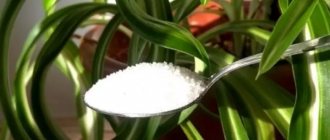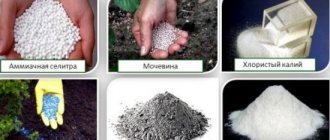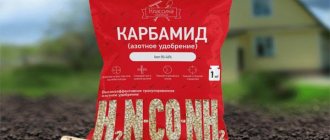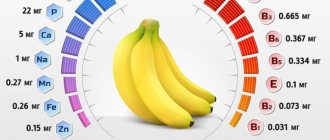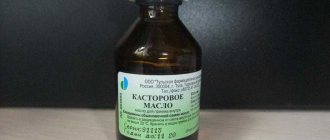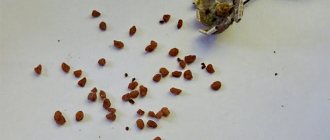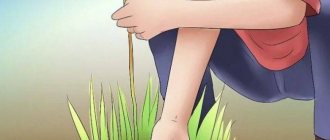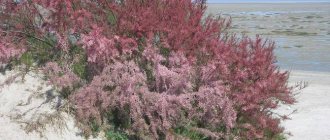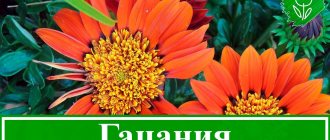For all gardeners, working in the garden most often brings sheer pleasure. It’s so interesting to plant a tuber in the ground and see how nature allows something beautiful to develop. Centimeter by centimeter, the green sprout reaches higher and higher towards the sun, some time passes, and it is already a strong and powerful plant that produces lush flowers and gives a stunning floral aroma as a reward to the gardener for his efforts. At such moments, the summer resident agrees to work until his back and legs become tired, just to watch how the plant can bloom.
Mulch - fertilizer for garden flowers
A very good option is to mulch the soil. Many gardeners use organic materials for this purpose: rotted compost, decomposed peat, rotted leaves, and mown grass.
Mulch applied under flowers decomposes over time and enriches the soil with additional nutrients. At the same time, it can become an obstacle to the germination of weeds. They cannot break through it and die.
Mulching can be done twice per season: in spring and autumn. In the first case, it will additionally serve as protection against temperature fluctuations and retain moisture in the soil. Gradually decomposing in warm weather, the mulch contributes to a looser state of the soil surface. This means that flower roots can develop freely in it. In September, spring mulch is replaced by composting.
Mulching material added in the fall helps plants tolerate frosty, windy weather more easily. It protects the ground from deep freezing, which makes it easier for flowering plants to winter. In the spring it is simply embedded in the soil.
Important! If mowed grass is used as mulch, it must be watered with a solution of nitrogen fertilizers and loosened more often.
How to use mulch?
Many modern gardeners use the bark of various trees as mulching material. It takes a long time to decompose, up to 2-3 years. Typically, for perennial flowers, a layer of 3-5 cm is poured.
If there is a spruce forest near the site, you can collect coniferous litter. Rhododendrons love it very much. For them, adding a layer of 5-7 cm is enough. But you should know that needles increase the acidity of the soil. Therefore, they are not suitable for all garden plants.
The most popular are manure humus and compost. A layer of 5 cm is poured under perennial flowers. The main thing you should pay attention to is that there are no remains of weeds in them.
On a note! Roses and lilies love mulching with nut shells. If they grow in your garden, then when you crack nuts, do not forget to collect it for your pets. You can use anything from pine nuts, walnuts, peanuts, hazel.
Mineral fertilizers for flowers in the country
How to feed flowers for lush flowering? Mineral fertilizers are the fastest and easiest method of feeding garden flowers. Only with their help can flowers develop in poor soils. They especially need mineral fertilizers on sandy and clay soils. Mineral fertilizers are nitrogen, potassium, phosphorus and complex.
Nitrogen fertilizers
Nitrogen fertilizers are applied in the spring, regardless of organic fertilizers, and then during the growing season as additional fertilizing. Nitrogen is very important for rapid plant growth. With its deficiency, the leaves become pale and small, and their density suffers.
Tips and tricks
When feeding plants, you should always pay attention to the composition of the soil in which they grow. If the soil is poor, the amount of fertilizer should be increased. If the soil is fertile, two feedings per season will be enough.
You should understand! At different periods of agricultural development, it requires different feeding. At the very beginning of sap flow, nitrogen fertilizers are applied, at the moment the buds appear - potassium and phosphorus, with the development of full-fledged flower stalks - superphosphates, in the fall - phosphorus and potassium.
Even a novice gardener can create a wonderful flower garden, thanks to fertilizers that will preserve the quality and decorativeness of the plants. It is recommended to create your first flower beds from unpretentious flowers, then gradually comprehend the science of floriculture in practice.
3 1 vote
Article rating
Fertilizers with phosphorus
Phosphorus is necessary for the development of the root system and the ripening of plant tissues. Thanks to him, they become more resistant to adverse weather conditions. Phosphorus is applied as a fertilizer for flowering perennials.
Phosphorus fertilizers are either water-soluble or sparingly soluble. The latter include phosphorus and bone meal, which are rarely used.
Superphosphate
Simple superphosphate comes in powder and granular forms. Both dissolve well in water, but leave sediment at the bottom. Granulated superphosphate contains up to 22% phosphorus and is better absorbed by flower roots. It is applied during spring and autumn tillage, when planting plants and as a top dressing. To plant perennial flowers in a hole, just add 1 tbsp. fertilizers
Important! Fertilizing with phosphorus fertilizers is combined with potassium fertilizers. This “commonwealth” promotes the best absorption of elements.
Double superphosphate contains up to 50% phosphorus. It is very convenient to store, as it does not cake, and consumption is halved. The drug dissolves well in water without sediment.
Feeding with superphosphate can be carried out either in dissolved or dry form. The latter is preferable in cold and wet weather. To apply superphosphate in liquid form, add water and leave for 2-3 days. Then drain the top and use the sediment for compost.
They are used for plants with a long growing season: clematis, lilies, roses. Annuals with a long flowering period also need phosphorus fertilizing.
Nutrient requirements of flower crops
(adsbygoogle = window.adsbygoogle || []).push({});
The nutrients a plant needs depend on the growing season and plant characteristics. Flowers with a short growing season, such as spring bulbs or primroses, require fewer nutrients because their above-ground parts die off quickly. But the amount of nutrients they consume in a short period of time is very large, and even the soil, well fertilized before planting, often cannot satisfy this need, so additional nutrition is necessary for the normal formation of bulbs or preparing plants for the dormant period. Flowers with a long growing season need more nutrients, but their consumption is spread out.
In spring, flower crops, like most other plants, need nitrogen, which can be added in the form of organic or mineral fertilizer. However, an excess of this element can lead to a delay in flowering and the formation of a small number of buds.
The most important element that flowering plants actively use is potassium. It is actively removed from the soil in all periods, and the need for it increases sharply in cloudy weather and when the length of daylight hours decreases.
Potassium preparations
Potassium fertilizers increase the resistance of flowers to adverse weather conditions and improve the quality of seed material. This fertilizer must be applied to all flowering plants.
Potassium sulfate
This is the best potash fertilizer that does not contain chlorine. It contains up to 48% potassium. It is well retained in the top layer of soil and promotes intensive root growth. It is applied to the soil when preparing flower beds for planting flowers and as a liquid fertilizer. For 10 liters of water use 1 tbsp. powder.
Calimagnesia
On sandy and sandy loam soils it is better to use potassium magnesia, since plants on them suffer from a lack of magnesium. The fertilizer contains up to 28% potassium and 9% magnesium. Can be added dry at the rate of 1 tbsp. per 1 sq. m landings.
Criterias of choice
As soon as flower lovers observe the following “symptoms”: slow growth, thin and weak stems, lack of brightness of the leaves, no color, the appearance of yellow spots, then the question arises, which is the best drug to buy to improve the condition of the crops. There is no consensus on this matter. Which company is better depends on a person's preferences. You can buy a Japanese-made product, which cannot be classified as a budget option, or you can buy an inexpensive Russian-made drug that will show miracles of recovery.
It is worth keeping in mind that the aggregate state of fertilizers can be of two types:
| State | Advantages | Flaws |
| Liquid | Economical, long shelf life. | Takes longer to digest. |
| Solid | Convenient to use, quickly absorbed by flowers. | The solution is prepared for one watering. |
Where to buy the fertilizer you are interested in? There are special points where they sell high-quality products of this kind. According to buyers, you can order fertilizers online in an online store, or you can make them yourself at home. Everyone chooses based on their material well-being and availability of free time, as well as the desire to do something with their own hands.
Complex mineral fertilizers
More often they use complex fertilizers, which already contain basic chemicals.
Nitrophoska
Universal flower food contains nitrogen, phosphorus and potassium in equal amounts (17% each). It does not cake easily and dissolves easily in water. Suitable for any type of soil. In dry form, add 1 tbsp after abundant moistening of the soil. per sq. m.
Potassium monophosphate
At the initial stage, I usually use a rooting agent with a high phosphorus content, but it is not on sale now. If I cannot find a rooting agent, I will use monopotassium phosphate with the formula 0-52-34 for this purpose, that is, there is no nitrogen in this preparation at all. I purposely name the formulas to make it easier for you to navigate.
By watering seedlings with monophosphate at the initial stage, you will promote their active rooting, but will avoid the excessive development of the vegetative mass: your seedlings will not stretch. And although monophosphate does not contain the main rooting substance - succinic acid, you can always add it.
To prepare 10 liters of solution you will need 20-25 g of potassium monophosphate and 2 g of succinic acid.
Organic fertilizers for flowering plants
Organic fertilizers improve soil structure. The effect of organics manifests itself gradually over a long period of time. Organic fertilizers, in addition to the main elements, often contain a large set of microelements necessary for the development of flower plants.
Humus
The most valuable organic fertilizer obtained as a result of the complete decomposition of manure, leaves, plant residues, and household waste. It is especially necessary on sandy and sandy loam soils.
To prepare manure humus, it is placed on material that does not allow moisture to pass through, the top is also covered to prevent the ingress of plant seeds, and it is left for several years. After complete decomposition, it is used the next year.
Apply as a mulching material or embed into the soil by loosening. For 1 sq. m add up to 1 bucket of humus.
For liquid feeding, it is dissolved in water in a ratio of 1:5. Leave for 3-5 days and water at the root.
Bird droppings
Chicken manure is effective for feeding garden flowers. It contains a large amount of concentrated substances, so it is used only in liquid form. Before use, it is dissolved in water at a rate of 1:10. Keep for 3 days. Before use, further dilute 1:1. Fertilizing with chicken droppings is done on moist soil, trying not to get on the plant itself. Afterwards the soil is watered again.
In autumn, dry droppings can be scattered over the surface of the flower bed at the rate of 1 bucket per 2 square meters. m flower garden.
Wood ash
Wood ash is easily absorbed by all flower plants. It contains a large set of microelements. Depending on the material from which the ash is obtained, its potassium content varies. The younger the burned plants, the more potassium. But the phosphorus contained in the ash is absorbed by plants much better than from superphosphate.
When planting perennial plants, it is enough to add 1-2 cups of ash into the hole. To feed in liquid form, ash is dissolved at the rate of 2-3 cups per 10 liters of water. Mix thoroughly and incubate for 3–5 days.
Dolomite flour
It contains 28% potassium and up to 20% magnesium. Used to alkalize soil. Apply regularly, every 2–4 years. The drug has a beneficial effect on plant development.
Thanks to him:
- the soil becomes healthier;
- the number of worms and beneficial microorganisms increases in it, and beetles, mites and flies die;
- Due to the formation of many young roots, the green mass increases, shoots and leaves grow faster.
Dolomite flour is added in dry form at the rate of 1 cup of powder per 1 square meter. m area. Then they are sealed using shallow loosening. Can be scattered on the snow to be absorbed into the soil with melt water.
Universal (organomineral)
"Ecofus" based on algae
A unique organomineral fertilizer that works due to the power of seaweed. Includes more than forty active nutrients, trace elements, amino acids, vitamins, enzymes, and natural antibiotics. Properties: immunostimulating, antiviral, antibacterial, fungicidal. Helps plants breathe, metabolize, and produce large, strong flowers. Improves soil structure and breathability. The manufacturer recommends a combination of spraying and watering.
Advantages:
- Super useful components;
- Increasing soil fertility;
- Flowering stimulator.
Flaws:
- Not detected.
Gumi-Omi Potassium Potassium Sulfate
The fertilizer produced by OZHZ Kuznetsov is a heterogeneous mixture consisting of powder, granules and agglomerates. As can be seen from the NPK indicators (0.5:1.25:30), it contains a lot of potassium. In addition, it contains humic acids, macro and micro elements, as well as 6% organic compounds. Potassium deficiency is visible in the appearance of the leaves; the edges turn yellow and become covered with “rusty” spots. Potash fertilizers are especially effective in peat and sandy areas. This is a popular group of fertilizers, not only for flowers. Customer reviews indicate that with the addition of Gumi-Omi, the plant comes to life, looks healthy, and delights with long-term flowering or a bountiful harvest.
Advantages:
- Universality, for all plants;
- Composition two in one: organics and minerals;
- Soil restoration;
- Visible effect.
Flaws:
- Not detected.
Miracle spray “Flower Paradise” Bui fertilizers
Liquid complex composition for the care of plants, decorative foliage and flowering plants. Suitable for indoor flowers and those growing in the garden or country house. NPK 0.23:0.23:0.34, as well as magnesium, iron, zinc and other trace elements. On the packaging there are tips on the amount of application: from March to September 1 time per week, from October to February 1 time per month. Customer reviews are the best: the effect is visible after a couple of days, it stimulates the compaction of leaves, the development of buds, and lush flowering.
Advantages:
- Ready-to-use solution;
- Independence from the season;
- Quick results;
- Economical consumption.
Flaws:
- Not detected.
IRIS OHYAMA INC Japanese Green Universal Fertilizer
The functionality of the Japanese-made product is striking in its diversity: it protects against excess moisture, aridity, and frost; increases resistance to pests and diseases; stimulates growth and root formation; guarantees abundant, long-lasting flowering. Designed for flowers, potted and decorative foliage crops. Formula of nitrogen, phosphorus, potassium, magnesium, copper, iron, zinc and other elements. Manufacturer's recommendations for use: for intensive healing, insert the bottle into the pot at an angle of 45 degrees. Another way: dilute 8 drops per 5 liters of water for large areas and healthy plants. According to buyers, spraying is no less effective.
Advantages:
- Balanced composition;
- Variety of applications;
- Visible performance;
- Wide range of effects.
Flaws:
- Not detected.
What time and how many times should I feed flowers in the garden?
At each stage of development, garden flowers require different types of fertilizers. This is due to the fact that perennials develop wildly in the spring, then bloom, and retire in the fall. Spring small-bulbed flowers and tulips, on the contrary, are only planted in the fall so that they bloom in early spring. Therefore, it is very important to know the stage of flower development in order to help them develop correctly in time.
Important! It is necessary to follow the recommended dosage of fertilizer mixtures. Usually the package indicates the proportion of mineral fertilizers used for each type of plant.
The fertilizer application scheme for perennial garden flowers looks like this:
- spring fertilizing with nitrogen fertilizers for growth (15–20 g/sq. m);
- during the formation of buds - water the roots with organic fertilizers (1:10) with the addition of 10 g of ammonium nitrate and 15 g of potassium sulfate per bucket of solution;
- in July, liquid fertilizing with ammonium nitrate, potassium sulfate and superphosphate (15 g: 15 g: 20 g per 10 liters of water);
- August - superphosphate and potassium for better ripening of shoots and seeds (15 g per 10 liters of water).
How to fertilize annual flowers? A combination of organic and mineral fertilizers.
- April - infusion of mullein or bird droppings (1:10);
- May - nitrophoska or Kemira (15 g per 10 liters of water);
- June - mullein infusion or complete mineral fertilizer (7-10 g per 10 liters of water).
Spring bulbous
- April - 15–20 g of ammonium nitrate per 1 sq. m;
- May—15–20 g of Kemira or nitrophoska per 10 liters of water.
The role of nitrogen
First of all, the use of nitrogen for plants affects the development of green mass - stems and leaves. It is contained in chlorophyll and is involved in the processes of photosynthesis and is part of the resulting organic compounds. The most nitrogen is contained in young leaves and shoots, colored bright green. Gradually the substance goes into new cells and the leaves darken. The content of this mineral also affects the yield, because the nutrition of the fruit is provided by the green mass.
Nitrogen-containing fertilizer
A plant with a lack of nitrogen has the following symptoms:
- growth slows down;
- old leaves turn yellow-green or red;
- some of the fruit ovaries fall off;
- the fruits grow small and hard.
Nitrogen in too large doses can be dangerous. Excess mineral accumulates in all parts of the plant. In fruits it forms nitrates and nitrites, which are hazardous to health. The accumulation of nitrates is also promoted by a lack of iron and molybdenum. Excess nitrogen provokes too rapid development of greenery, which interferes with the formation of fruits.
Fertilizers containing nitrogen
To enrich the soil, this element is used in four forms.
- Nitrates (calcium and sodium nitrate) contain nitric acid, which is rapidly soluble in water. Suitable for acidic soils and fast-growing crops (radish, lettuce, parsley and others).
- The ammonium form is characterized by the presence of free ammonium ions (ammonium sulfate). Decomposes slowly and requires deoxidation (for example, with lime). Used for plants with a long growth period (onions, cabbage and other vegetables).
- Urea is nitrogen in amide form and also requires deoxidation. Suitable for pre-planting soil preparation and fertilizing with solution. It is applied under fruit trees and bushes.
- Ammonium nitrate is the ammonium nitrate form. This acidic substance consists of two parts, one of which dissolves quickly and the other slowly. Used for feeding vegetables.
